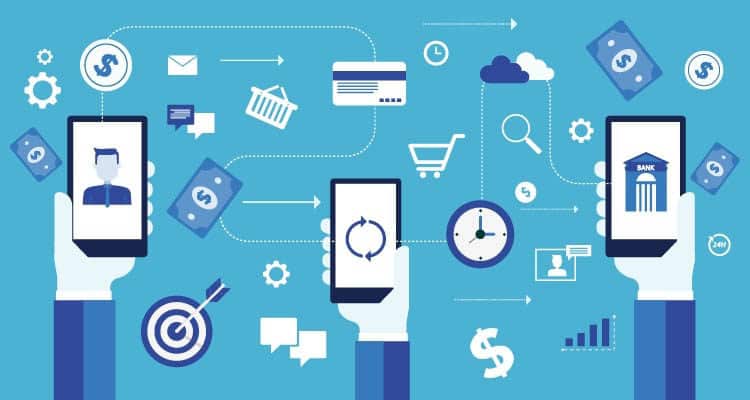One of the best ways to meet your clients’ rising demands is to provide them with a variety of payment choices. What kinds of online payment methods are there? And how do they alter based on the countries you wish to target around the world?
This post has a list of the 10 most popular online payment methods that a small business can utilize. To assist you with international expansion, we also provide some samples of common payment methods in various countries throughout the world.
What are Online Payment Methods?
Online payment methods are systems that enable you to receive money from customers for purchases made online rather than in person or over the phone.
Several online businesses accept payments by credit cards, debit cards, or a direct connection to a bank account.
There are numerous online payment solutions available to business owners these days, but you should only choose those that are appropriate for your specific needs. You should also examine choices that can scale as your business grows, as well as methods that provide security and excellent customer service.
Best Online Payment Methods for a Small Business
To keep things easy, here is a list of the most popular online payment methods for a small business accessible today.
#1. Adyen
Adyen’s main goal is to be available everywhere. Adyen takes pride in its global coverage and device compatibility, with web, app, and in-store alternatives available. Other major features include integrated data insights and dashboards for performance monitoring.
#2. GoCardless
GoCardless, which is suitable for payments of all sizes, makes taking both recurring and one-time payments simple, with 97.3% of payments received successfully the first time.
Receive payments automatically from your customers for invoices, subscriptions, and ad-hoc sums by getting set up directly through their dashboard
If that wasn’t enough, IDC research found that GoCardless reduces the overall cost of accepting payments by 56%. GoCardless, which is suitable for payments of all sizes, makes taking both recurring and one-time payments simple, with 97.3% of payments received successfully on the first try.
You can keep transaction fees low and enjoy high payment success rates using ACH Debit and GoCardless, eliminate late payments by reducing manual payment administration, and safeguard customers against scam
#3. Google Pay
Google Pay, a significant participant among digital wallets, allows consumers to pay on your website using card details stored in the product. The payment option is distinguished by the distinctive “G Pay” emblem. It is quite inclusive, as hundreds of millions of users globally currently use Google Pay on their smartphones.
#4. Apple Pay
Apple Pay is the obvious Android counterpart to Google Pay. With an equally large number of existing customers, Apple Pay provides convenience when accepting payments on your website. Check out Apple’s Acceptable Usage Guidelines, as you’ll need to follow particular branding and user interface guidelines.
#5. PayPal
PayPal’s status as one of the most recognizable online payment methods in the world is a significant benefit of utilizing this service. It’s a reliable and secure service, although it costs 2.9% + $0.30 for every transaction at the time of writing. Other providers are likely to offer you the same service for a significantly lower price – GoCardless costs only 1% + $0.25 for each transaction, with a maximum of $2.50, on our simple, contract-free pricing plan.
#6. Stripe
Stripe is one of the most well-known payment gateways on the market and requires no introduction. It’s a massive service designed with online transactions in mind that give a dependable and slick experience. Additional advantages include multi-currency capability, which allows you to display prices in your customers’ local currency in over 135 countries.
#7. Amazon Pay
Amazon Pay, a more recent addition to the online payments industry, maybe a good fit for your business. It’s an international gateway that enables convenient checkout for everyone who already has an account on the site, which is practically everyone.
#8. Card companies
Facilities from well-known card firms make it simple for people who prefer card payments to complete their purchases on your website. Card payment channels for online use include Visa Checkout, American Express, and Masterpass by Mastercard. All three provide excellent customer service, integration assistance, and user identification.
#9. Square
Square is a well-known payment solution and one of the most effective online payment methods for small enterprises. They have you covered if you want to offer appointments, sell real or digital products, or run a restaurant that accepts online orders. This platform allows you to send invoices and/or collect payments, and it even provides a free eCommerce solution to help you get your business up and running.
Square provides everything from hardware for brick-and-mortar stores to e-gift cards and an analytics dashboard to track your progress. You can also handle your payroll with Square, from entering time cards to automatically paying employees, and open a Square checking account for your business with no costs. You may also quickly add shopping cart buttons, purchase links, and QR codes to help guide clients to your products and services using its online payment system.
#10. Buy-Now-Pay-Later Providers
Companies like Klarna and Afterpay are making a major impression as BNPL grows in popularity. People, particularly the more debt-conscious, are leaning toward interest-free installments, which lessen the need for big payments on credit card bills. You might wish to think about including this option as an increasingly popular alternative payment method.
Two Main Payment Systems.
We summarized the most common online payment methods available today to help you decide which is the best strategy for your business to collect online payments. It’s worth noting that each of these uses one of two basic payment systems:
ACH Debit (also known as Direct Debit or bank debit) (also known as Direct Debit or bank debit)
Card (credit or debit)
Here is a brief explanation of each online payment method below.
#1. ACH Debit
ACH Debit is an instruction from your customer to their bank that permits your business to withdraw funds immediately from their account when payment is due.
This is characterized as a ‘pull’ payment because, once authorized, the business automatically ‘pulls’ the payment from the client account without the customer having to take any further action. The fundamental advantage of pull payments is that they virtually eliminate late payments, boosting cash flow, and their automated nature decreases the amount of financial administration necessary.
While this may appear to be a payment method that benefits your company above your customer, there are a number of benefits for both sides (see benefits for payers and benefits for businesses), as well as restrictions in place to protect consumers.
ACH Debit is best suited to organizations that wish to be paid on time while minimizing transaction fees and human administration. Unfortunately, it is not appropriate for firms that require quick online payments (such as for e-commerce).
In comparison to card payments, ACH debit is less expensive and requires less accounting and payment administration.
Bank payment methods, such as ACH Debit, have lower transaction fees than cards since they are direct account-to-account transfers, whereas cards require the involvement of numerous middlemen, each of whom charges a fee, to complete payments.
#2. Debit (or credit) card
Credit and debit cards are the de facto default method of accepting payments online in various industries in the United States. A review of global business payment preferences reveals that this “desire” for cards is more of a historical habit that has persisted around.
Until recently, card payments were probably your best option if you needed to receive payments from customers quickly. But, with the rise of open banking, you may accept payments in real-time using services such as Instant Bank Pay.
Why Provide Many Online Payment Methods?
While it is feasible to get by with just one secure and simple online payment option, many customers are beginning to expect to use their preferred payment methods on sites all across the internet.
Customers are increasingly able to checkout on a variety of websites without having to spend time entering all of their payment and address information for each purchase, thanks to the growing popularity of services such as PayPal, Square, and Apple Pay. Instead, users merely need to log into a standard account, and in many circumstances, they may not even need to do so if their device remembers it.
This provides a more smooth and more convenient experience for them, particularly on mobile, where an increasing amount of online purchases are made. The more your visitors expect this level of convenience, the less likely they are to bother with a website that requires them to perform more work.
Adding Additional Online Payment Methods: Is It Truly Worth the Time and Effort?
Bayard discovered that 19% of shoppers who abandoned a cart did not trust the site with their credit card information. Another 8% stated unequivocally that there were not enough payment options.
So, let’s do some fast math: for the average eCommerce store, 70 out of every 100 shoppers who add an item to their cart will abandon their shopping cart. And 8-19% of those will do so because they are dissatisfied with the present online payment methods you provide.
You may convert up to 13 (or 19%) of those 70 shoppers by providing more online payment choices. And if you include the payment methods that your target audience prefers, you may be able to convert an additional 5 or so (the 8% who prefer other options).
Getting up to 18 extra conversions per 100 prospective customers appears to be a worthwhile investment of your time.
Popular Online Payment Methods From Around the World.
Every country is unique, so it’s not surprising that each country has its own set of preferred online payment methods.
Whatever payment choices you provide will be heavily influenced by who you’re targeting and how this group wants to shop online.
We’ve highlighted some of the most common online payment methods from various locations throughout the world below, which we recommend you consider when focused on reaching customers in a certain area.
Europe
Alternative payment methods, such as mobile payments, prepaid cards, eWallets, and ‘buy now pay later’ rapid financing, are estimated to account for 20% of the European market by 2020.
At the same time, credit cards remain popular throughout Europe, so getting the correct mix of payment choices is critical.
- Pay with bank cards: Mastercard, Visa, American Express, UnionPay, JCB, Maestro
- Pay using an eWallet: PayPal, Amazon Pay, Google Pay, Apple Pay, Yandex, Qiwi, Skrill
- Pay with money transfer: Sofort, iDEAL
- Pay by direct debit
- Pay with cryptocurrency: Bitcoin
- Pay with prepaid cards: SNAP, Paysafecard
- Buy now pay later: Klarna
North America
North America provides enormous opportunities to expand your online business as the world’s largest and most developed eCommerce market, with a disproportionally high annual growth rate of 45%.
Credit cards are currently the most popular payment option in the United States. Americans, on the other hand, are at the vanguard of more contemporary payment methods, such as one-click checkouts, mobile payments, and digital currencies.
- Pay with bank cards: Mastercard, American Express, Discover, JCB, Visa, Interac Online
- Pay using an eWallet: PayPal, Apply Pay, Google Pay, Android Pay, Samsung Pay, Neteller
- Pay with a money transfer: Skrill
- Pay by direct debit
- Pay with cryptocurrency: Bitcoin
- Pay with prepaid cards: Openbucks, Paysafecard
- Buy now pay later: Klarna, Afterpay
Asia
The Asian population, which numbers over 4.5 billion people and represents a varied spectrum of civilizations, use a variety of online payment methods.
For example, China boasts the world’s largest online retail industry and leads the way in mobile commerce, yet India has traditionally been a cash-dominated country.
- Pay with bank cards: UnionPay, Mastercard, Visa, JCB, RuPay
- Pay using an eWallet: WePay Chat, AliPay, Paytm, Apple Pay, Google Pay, GCash, PayPal, GrabPay, PayU Wallet, Mobikiwi, Citrus Pay
- Pay with a money transfer: SMART Money
- Pay with cryptocurrency: Bitcoin
- Buy now pay later: Afterpay, LazyPay
- Pay with cash later: Konbini
New Zealand and Australia.
Card payments continue to be the most popular method of online payment in Australia and New Zealand. Other payment methods, such as eWallets and real-time bank transfers, are becoming increasingly popular.
Furthermore, with a thriving retail and tourism economy, Australia and New Zealand offer excellent opportunities to reach worldwide audiences.
- Pay with bank cards: Visa, Mastercard, American Express, JCB, Discover
- Pay using an eWallet: PayPal, Apple Pay, Samsung Pay, Google Pay
- Pay with a money transfer: Poli, BPay
- Pay with cryptocurrency: Bitcoin
- Pay with prepaid cards: Paysafecard
- Buy now pay later: zipPay, Klarna, Afterpay, Openpay
Conclusion
Individuals are increasingly conducting the majority of their transactions over the Internet. People can make consumer purchases, pay off debt, and execute practically all bank transactions. As a result, many of these alternative payment methods that rely on mobile devices or web-based applications are likely to be physical payment methods such as cash, paper checks, and even payment cards.
- WHAT IS ACH PAYMENT? How It Works
- Ach Credit: All you need to know detailed(+ free tips)
- TYPES OF PAYMENT METHODS: Full List and Explanation
- WHAT IS NSF FEE? Overview and Comprehensive Guide
- How to Fill Out a Money Order Correctly: Step-by-Step Guide






